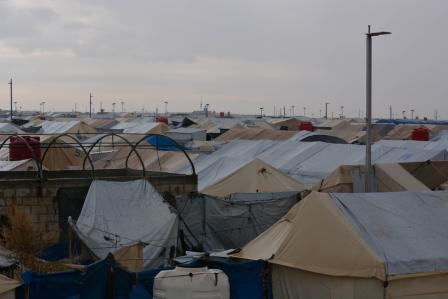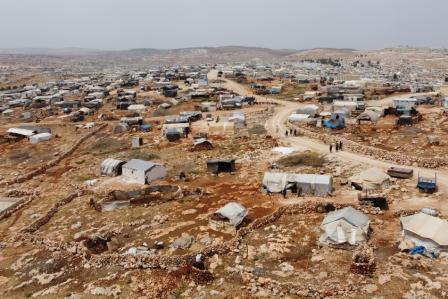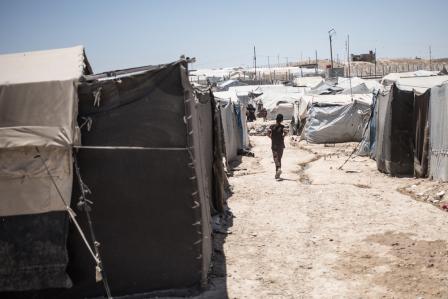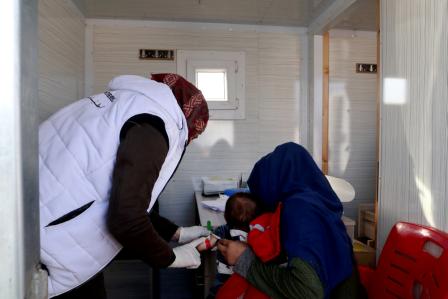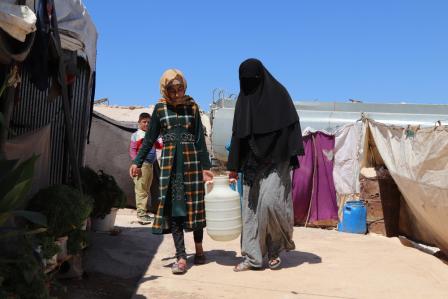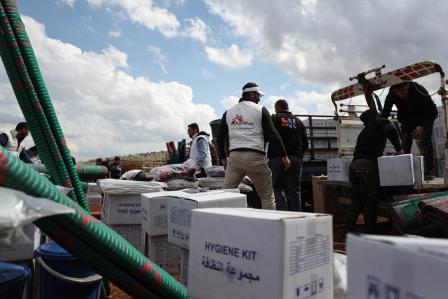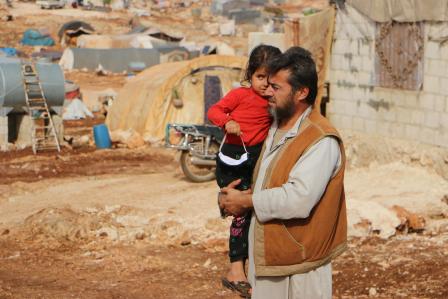Syria: 11 years of war through a Syrian Doctors Without Borders Hospital
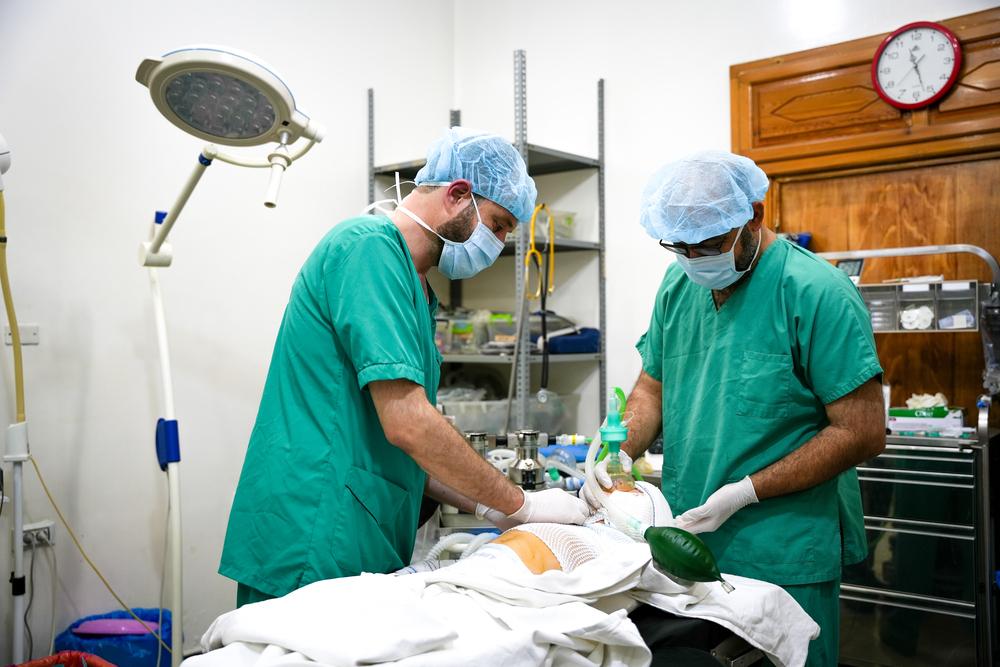
The nursing team is performing the final medical procedures before removing the child from the operating room after undergoing surgery. Syria, October 2023. © Abdulrahman Sadeq
In 2012, a year after war broke out in Syria, Doctors Without Borders / Médecins Sans Frontières (MSF) opened a burn care unit in Atmeh, in northwestern Syria’s Idlib province. It is currently the only facility treating burn patients in northwestern Syria—home to more than more than 4.5 million people, most of whom are displaced. Abdel Malik Araour, Doctors Without Borders nurse supervisor, has worked at the clinic since it opened. Dr. Moheeb recently joined the team to develop the reconstructive surgery program. Here, they talk about what they have been able to achieve at the clinic, huge gaps that remain in the health care system, and the unacceptable living conditions that several million people endured for years.
“We are alone in this huge community, to take care of people suffering from burns”
Following Dr. Moheeb around the inpatient department (IPD) is not an easy task. He is constantly on the move with so many patients to see, most of whom are young children, with severe burns. He asks each patient or their relatives: “What happened to you? How did you get burnt? Where are you from? Are you living in a house or in a camp?” He then explains the medical procedures, so that the patients and their caretakers can understand the treatment—as he used to when he was a professor at Aleppo University, before the war.
“Here in the region, for ten years there had been no electricity network,” said Dr. Moheeb. “It only came back a year ago, in and out. Many children don’t know about electricity. This is one of the reasons why they easily get burnt by it.” But according to Dr. Moheeb, the major problem is bad fuel. “This cheap fuel that we have is actually pure fuel. It contains a lot of gas and [explodes] easily. This is how most women and children get burnt. We need more to [spread] awareness to people.”
Families are larger now than they were before the war. Most people are living in tents or other makeshift shelters. Children are home most of the time as there is no school. Many children are agitated because of compounding trauma for years, most recently triggered by the earthquakes in February 2023 that killed and displaced thousands of people in Syria and Turkey. Doctors Without Borders's teams see that domestic accidents are the main cause of burns, and most of these accidents happen to children, either who are burned by spilled boiling water or by heating system explosions.
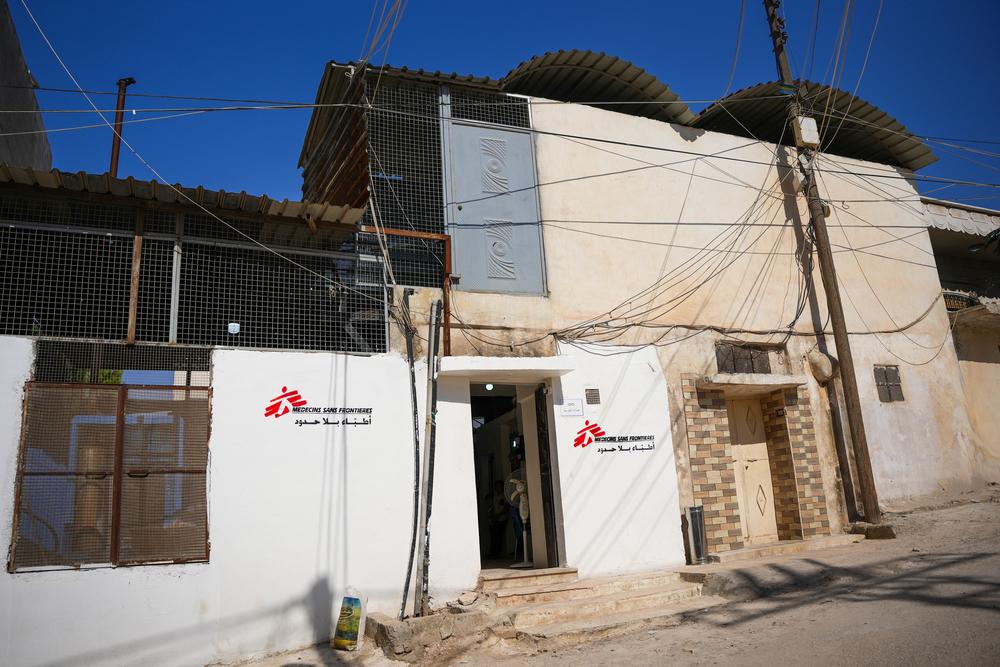
The entrance of the burns unit in the town of Atmeh in northwest Syria. Syria, October 2023. © Abdulrahman Sadeq
These injuries are directly linked to the poor living conditions as a result of more than 12 years of war. The risk of burns is even greater in tents as they are highly flammable and because of the number of people living in a small space. If that happens, often the whole family suffers burns, and six or seven patients arrive at the hospital for treatment at once.
Doctors Without Borders and other NGOs are conducting fire risk awareness sessions in refugee camps in the region. But two million people live across 1,532 camps and informal settlements in northwest Syria—so our teams cannot reach everyone. And while raising awareness can prevent some accidents, it does not improve the dangerous living conditions. “We need to advocate for the authorities to understand the problem and buy better quality of fuel,” says doctor Moheeb. But this would be difficult to achieve as the cheap fuel comes from northeastern Syria, where there are no proper refineries. Better quality fuel is expensive and is imported from abroad, which under the current economic circumstances is not accessible to most inhabitants of northwest Syria.
Funding for northwest Syria is decreasing after a temporary increase linked to the earthquake, so there is little hope for improving fuel quality and living condition while this trend continues.
After the earthquake, the Burn Unit expanded to accept more patients, as it remains the only place left to treat burn injuries inside northwest Syria
A health care system should usually be a network of facilities. Each medical facility should complement each other, addressing different needs. But in northwestern Syria, plagued by more than a decade of war, the health system is too weak to stand on its own and depends on Turkiye’s support for a wide range of specialized care, including severe burns.
Before the February 2023 earthquakes, Doctors Without Borders burn unit was treating children with burns covering about 20 percent of their body surface, and adults with burns covering about 40 percent of their body surface. Patients that were had larger burns were referred to Turkiye, through the bordering Bab al-Hawa office for medical referrals. Through this unique corridor, they received care through the Turkish health network, which is more developed and comprehensive than what is available in northwestern Syria.
After the earthquake, the damage to the Turkish health system was enormous and the Bab al-Hawa cross-border referral office was closed for almost two months.
“The closure of the border crossing Bab al-Hawa after the earthquake has been a huge challenge for us,” said Abdel Malik Araour, nurse activity manager, who has worked at the burn care unit since it opened.
We [started] receiving patients with [larger] burns [up to] 55 percent, and almost all were young children. And burns are more dangerous for children than for adults. A children’s life is in danger when burnt widely, above 40 percent, whereas adults can resist better. There are no other medical facilities where we can refer the patients. There is no hospital other than Doctors Without Borders for burn patients in northwest Syria. So, we had no choice but to find a solution for them. This is our duty to receive them and take care of them, even though they are not in our criteria. This is how we’ve tried to increase our capacity.Abdel Malik Araour
Before March 2023, Idlib surgical hospital had a small ward dedicated to burn patients. But it had to close at the end of march, as the international financial support it was receiving stopped. Since then, all the burn patients of northwestern Syria now seek care from Doctors Without Borders.
After the earthquake, Doctors Without Borders teams mobilized to transform the medical facility and adapted their care to be able to increase capacity. They managed to open 12 new beds, increasing the capacity from 17 to 29 beds. Additionally, they opened advanced points for people to be discharged from the hospital and receive follow-up care, like mental health care, dressing and physiotherapy, closer to their homes. This increased the number of emergency care and surgery patients they could care for. It also decreased the number of patients that would stop their treatment as they couldn’t afford to travel to receive follow up care.
Receiving such severely burnt patients has raised another challenge, because at some point these patients need to be admitted in an Intensive Care Unit (ICU).
A critical lack of beds in intensive care units (ICU) in northwest Syria
Burn patients are at high risk of infects. They are suspectable to high fever, severe respiratory and problems—signs of sepsis. If this happens, they require very close attention and special care. When someone has burns to more than 40 percent their body, the respiratory system suffers. This often requires intubation, which can only be done in an ICU with proper equipment and where patients are closely monitored. Doctors Without Borders Burn Unit doesn’t have an ICU. Mohamed Darwish, director of the hospital, explains the efforts made by the team to adapt and find solutions for these patients, when referrals to other facilities in Turkiye stopped after the earthquake.
“First, we have contacted many hospitals, asking them to receive these patients in need of ICU, but right after the earthquake, all of them refused, except a pediatric hospital. Hospitals feared burn patients would transmit infections to other patients. But this pediatric hospital agreed to collaborate with us and to receive children patients in their ICU. However, they had only two beds for intensive care. Later, Idlib hospital also accepted some of our patients.”
When a patient is admitted to an ICU at another facility, Doctors Without Borders’s medical team continues to care for their burns. Five-year-old Majid has burns to 45 percent of his body. After operating on him, Doctors Without Borders referred him to Idlib hospital, with close follow-up by our own operation theatre team. At the same time, they were trying to get him accepted for follow up care in Turkiye. After a month, when the cross-border referral system slowly re-opened for one or two life-saving cases per week, he finally was accepted.
“As far as we know, he is still in Turkiye and in a difficult situation, with respiratory problems. Sometimes it is heartbreaking,” says Hiba Birawe, who supervises the mental health support provided to the patients and their caretakers, and had been in touch with Majid’s family daily.
- When “Miracle” patients give strength to go on
One patient is remembered as a “miracle” by the whole Doctors Without Borders team. Considered a ray of light during this challenging period. Her name is Tuqa. She is a 10 years old and suffered from burns to 45 percent of her body. Far more severe than what the team usually sees. She was injured by boiling water at home. Abdel Malik shares her story:
“She spent a full month in our hospital. After that, we referred her to the pediatric hospital where she was admitted to the ICU. She stayed there for 15 days, intubated. We provided the pediatric hospital with the specific medication she needed. We also sent a surgeon, an anesthetist doctor, nurses for dressing change, and our medical materials to support the medical team of this hospital. When discharged from ICU, the patient came back to the Burn Unit to be operated on. We did small skin grafts for all her body, to avoid scarring and infection, step by step, cautiously. We cannot do only dressings, or her skin would become more prominent and form scars."
“Now, Tuqa is discharged from both hospitals and she is feeling well. This was an amazing success! Overall, she stayed more than two months in hospitals. Now, she is healed, she is walking and talking. She comes to our medical facility only for follow-up care. This happened in April, when the referral system with Turkiye was still completely blocked.”
11 years of Doctors Without Borders presence in Atmeh in a land locked area
For eight years, the escalation of the conflict prevented Doctors Without Borders international staff to be physically present inside northwest Syria between 2014 and 2022. Doctors Without Borders’s Syrian team has been running the facility on their own, with only remote support. They have been supporting their local community and were the first to respond to the earthquake emergency, deploying staff, opening the warehouses and ambulances in the very first hours.
“The war has cut us off from the outside world since 2014, almost until the earthquake. Only after this were our colleagues able to visit us, as authorization to enter Northwest Syria became less [restricted]”, says Abdel Malik Araour.
For Doctors Without Borders and for other organizations, the eased access to northwestern Syria after the earthquake and numerous assessments and visits since then paved the way to a renewed awareness of the dramatic situation faced by people there. After 12 years of war and a decade of relying on humanitarian support, the closure of the referral system to Türkiye meant thousands of patients in the region would have no access to lifesaving care. NWS health system is still highly dependent on aid and vulnerable.
Regarding Atmeh, it has also been the opportunity to acknowledge the remarkable experience and commitment of Doctors Without Borders Syrian team throughout these incredibly difficult years.
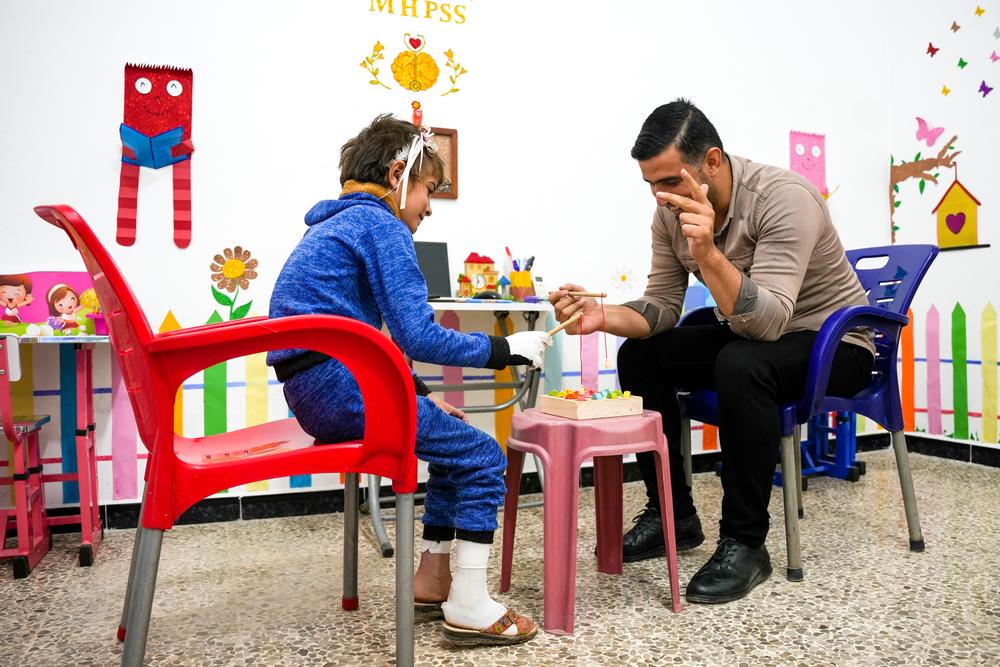
Burn unit mental health team is carrying out recreational activities with seven-year-old patient, to adapt her to her surroundings again after she suffered severe burns to her hands while playing with her brother next to diesel at their home in northwestern Syria. Syria, October 2023. © Abdulrahman Sadeq
Doctors Without Borders calls for more support to help the development of specialized care inside northwest Syria
Providing quality care for burn patients requires extensive experience, long stays in the hospital, and high costs. Therefore, it has proven particularly difficult for other hospitals to maintain this activity at a time of uncertain and decreasing funding.
Doctors Without Borders is calling for more heath organizations to support the development of specialized, sustainable care in northwestern Syria to ensure access to lifesaving care for this community that is facing the consequences of more than 12 years of war.
What are the new horizons for the victims of burns in northwest Syria?
Doctors Without Borders continues to support the victims of burns in northwestern Syria. Doctors Without Borders is currently constructing a larger upgraded facility near the current burns care unit. In about a year, it will be ready to welcome patients and replace the current facility, renewing our commitment to quality and multidisciplinary care and the ability to provide follow-up treatment to patients.
“Inside the new burns unit, there will be an operating theatre fully dedicated to reconstructive surgery,” says Dr. Moheeb, enthusiastically. “We will be able to provide surgeries that are impossible to get in the whole region of northwestern Syria at the moment”.
